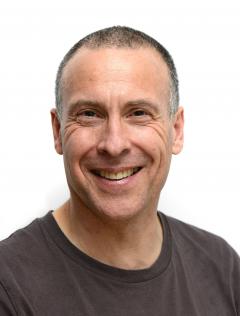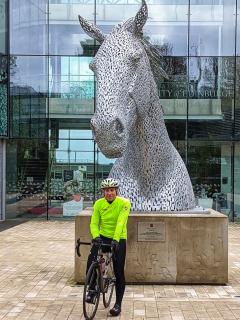Dr Tom Burdon on studying livestock in a dish
Understanding different immune responses in wild and commercial pigs, and being driven by a sense of adventure in research.

Dr Tom Burdon is a Group Leader at the Roslin Institute, where he studies stem cells to understand the biology of pigs and cows. In this interview, he talks to MSc Science Communication student Rachel Bass about his work and his love of scientific exploration.
Could you tell me about your work in a nutshell?
I am interested in how cells change their fate and how those changes are controlled. We use embryonic stem cells to study these changes. These are cells that come from the very early embryo – that’s day three or four of development in mammals – and they can turn into any cell type. We’re interested in how stem cells stay stem cells, and how they turn into specialised cells through a process called differentiation.
More recently we’ve been trying to apply stem cell biology to livestock research, so we’re basically trying to put livestock in a dish. The idea is that we capture a livestock stem cell – we currently have pig and cow cells in the lab – and model some of the cell types that might be useful for studying important aspects of livestock, by looking at how the cells change. At the moment, we’re concentrating on using stem cells to make white blood cells called macrophages, which are the first line of defence against infections. We’re working with colleagues to study how macrophages respond to infections. We model the biology of the animal in a dish.
What is the benefit of studying biology in a dish?
We can take some proteins that we know are involved in stem cell biology and convert adult cells into stem cells, which helps reduce the number of animals used in research. The reason why we are excited by this is we can take cells from an adult animal, such as a wild pig, and we can make stem cells from them. So we can study the biology of African wild pigs in a dish in our labs without having to study the animals in the wild.
This opens up the possibility of sampling the genetic and physical diversity of the wild population. Part of the reason we’re interested in these wild pigs is they have different responses from domesticated pigs to some diseases, so we are trying to understand the basis of that.

Could you talk about those differences between wild and domesticated pigs?
They have a wildly different reaction to one particular virus – called African swine fever. All wild African pigs coexist with this virus, so they carry it and don’t get sick. But if a domestic pig gets infected with swine fever, it dies in a week. We’re interested in understanding why wild pigs can carry the virus and are apparently happy, and the domestic pigs are so sensitive to it. By comparing the cells of wild and domesticated pigs in the dish, we are beginning to understand the reasons for that difference and may understand how to make our domesticated pigs more resilient in the face of African swine fever.
What do you like about working at Roslin?
We have a diverse collection of very good scientists here. I think the fun part is learning about other subjects colleagues work on and seeing how they intersect with each other. In some areas of science, you can be very concentrated on just one specific area. I quite like the fact that it’s a bit broader here. I can hear about work with chickens, limb development or even fish genetics. I find that an interesting and stimulating environment.
What is your favourite part of being a scientist?
I think it’s that you have freedom to answer questions and to be an adventurer. There are not many jobs where you can explore how things work. I think that’s the exciting part of biology especially – you have the opportunity to see things that nobody else typically sees. You do experiments in the dish where the next day you might see something that no-one else has seen before.
If you could have tea with any scientist, living or dead, who would it be and why?
I would like to have a chat with the recently passed molecular biologist Sydney Brenner. He used to share an office with Francis Crick, who discovered DNA, and they would spend the whole time shooting ideas backwards and forwards. Brenner took the discovery of DNA forward in terms of understanding how DNA is read and translated into proteins. Once DNA had been discovered, it opened a door to all these questions. There was a group of people, including Brenner, that were focused on these questions, and I think it must have been a very exciting time.
What might be the next door to open in biology?
One of the doors in biology is a confluence of three technologies – DNA sequencing where you determine what genes are present; gene editing where you’re able to modify any gene in almost any organism; and reprogramming and programming where you change cells’ fates. If you string those technologies together, which is what is now being done, you can model early embryonic development and make much more sophisticated models of early aspects of biology. I think all of those technologies coming together allow answering sophisticated questions about early developmental biology and cell fate.
What would you be doing if you weren’t a scientist?
For a brief time I thought I might become a fish farmer – but got side tracked after spending a summer as a lab technician preparing rat liver mitochondria for Open University Summer School students.
Related links
Stem cell study could curb need for animal tissue
Protein supports embryo cell survival under metabolic stress


